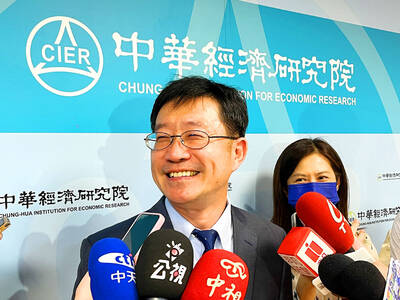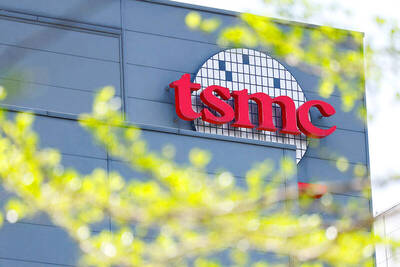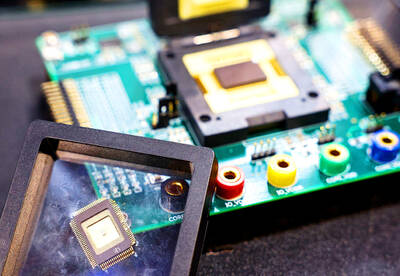The Taiwan High Speed Rail Corp (THSRC, 台灣高鐵) may launch a plan next year to develop areas surrounding major stations on its route, an official said yesterday.
THSRC chief executive officer Ou Chin-der (歐晉德) said that with the steady increase in passenger volume on the bullet train, which was launched in January last year, it made sense to develop the areas around key stops.
“Businesses need to invest more — even amid the economic downturn — and it may be a good time to promote the development of areas surrounding several major stops next year,” Ou told reporters.
The THSRC plans to boost its capital by between NT$20 billion (US$600 million) and NT$30 billion within three years to add three stops to the route, buy more train cars and develop areas around its busiest stations.
Ou said the high speed rail’s five main mid-route stops — Taoyuan, Hsinchu, Taichung, Chiayi and Tainan — all have plenty of room for development.
The THSRC will first form a development company to this end, which will focus on Hsinchu and Taoyuan stations first, as it will not have the means to work on all five stops simultaneously, he said.
The Hsinchu stop will be a suitable location for businesses related to the high-tech industry, Ou said, because National Chiao Tung University, National Tsinghua University and Hsinchu Science Park are all nearby.
The Taoyuan station is linked to Taoyuan International Airport and will be a good location for businesses that assemble high-tech products, Ou said, urging Hon Hai Group (鴻海集團) to consider the area.

WEAKER ACTIVITY: The sharpest deterioration was seen in the electronics and optical components sector, with the production index falling 13.2 points to 44.5 Taiwan’s manufacturing sector last month contracted for a second consecutive month, with the purchasing managers’ index (PMI) slipping to 48, reflecting ongoing caution over trade uncertainties, the Chung-Hua Institution for Economic Research (CIER, 中華經濟研究院) said yesterday. The decline reflects growing caution among companies amid uncertainty surrounding US tariffs, semiconductor duties and automotive import levies, and it is also likely linked to fading front-loading activity, CIER president Lien Hsien-ming (連賢明) said. “Some clients have started shifting orders to Southeast Asian countries where tariff regimes are already clear,” Lien told a news conference. Firms across the supply chain are also lowering stock levels to mitigate

Six Taiwanese companies, including contract chipmaker Taiwan Semiconductor Manufacturing Co (TSMC, 台積電), made the 2025 Fortune Global 500 list of the world’s largest firms by revenue. In a report published by New York-based Fortune magazine on Tuesday, Hon Hai Precision Industry Co (鴻海精密), also known as Foxconn Technology Group (富士康科技集團), ranked highest among Taiwanese firms, placing 28th with revenue of US$213.69 billion. Up 60 spots from last year, TSMC rose to No. 126 with US$90.16 billion in revenue, followed by Quanta Computer Inc (廣達) at 348th, Pegatron Corp (和碩) at 461st, CPC Corp, Taiwan (台灣中油) at 494th and Wistron Corp (緯創) at

NEGOTIATIONS: Semiconductors play an outsized role in Taiwan’s industrial and economic development and are a major driver of the Taiwan-US trade imbalance With US President Donald Trump threatening to impose tariffs on semiconductors, Taiwan is expected to face a significant challenge, as information and communications technology (ICT) products account for more than 70 percent of its exports to the US, Chung-Hua Institution for Economic Research (CIER, 中華經濟研究院) president Lien Hsien-ming (連賢明) said on Friday. Compared with other countries, semiconductors play a disproportionately large role in Taiwan’s industrial and economic development, Lien said. As the sixth-largest contributor to the US trade deficit, Taiwan recorded a US$73.9 billion trade surplus with the US last year — up from US$47.8 billion in 2023 — driven by strong

NEW PRODUCTS: MediaTek plans to roll out new products this quarter, including a flagship mobile phone chip and a GB10 chip that it is codeveloping with Nvidia Corp MediaTek Inc (聯發科) yesterday projected that revenue this quarter would dip by 7 to 13 percent to between NT$130.1 billion and NT$140 billion (US$4.38 billion and US$4.71 billion), compared with NT$150.37 billion last quarter, which it attributed to subdued front-loading demand and unfavorable foreign exchange rates. The Hsinchu-based chip designer said that the forecast factored in the negative effects of an estimated 6 percent appreciation of the New Taiwan dollar against the greenback. “As some demand has been pulled into the first half of the year and resulted in a different quarterly pattern, we expect the third quarter revenue to decline sequentially,”